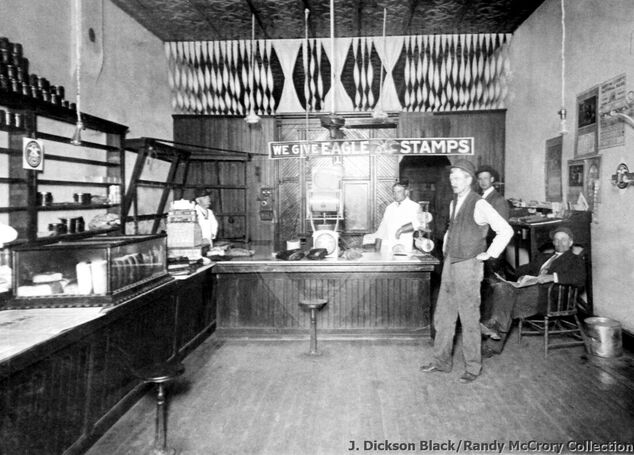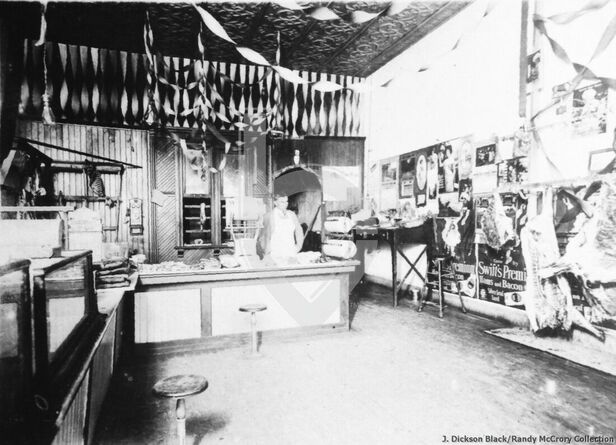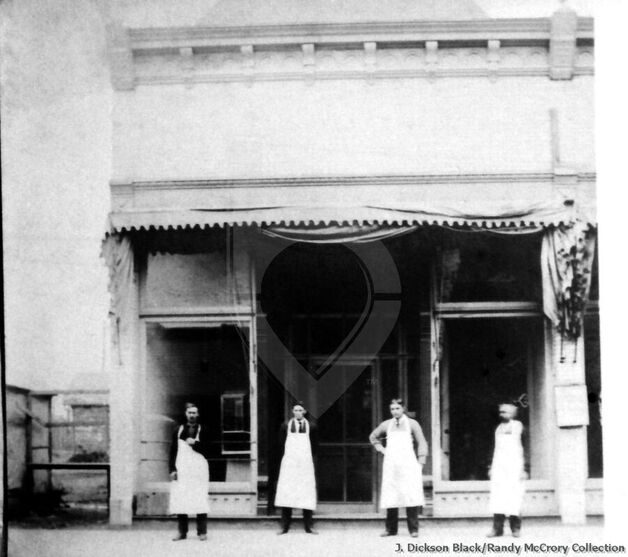Foster Meat Market in Bentonville
Taken from the Northwest Arkansas Times June 14, 1966
Taken from the Northwest Arkansas Times June 14, 1966
"Notice March 1st: We reduce the price of Loin and Round Steak to 10 cents per pound, Chuck Steak three pounds for 25 cents. Other meats accordingly. On the same day we start on a cash business strictly. This does not mean one, but means all, everybody. Respectfully, Wright and Foster Meat Market." This handbill was put out in 1899.
If you saw this handbill today, you would think you were dreaming, but it was no dream. Mrs. Winnce Foster Senter of Bentonville, has a copy of the handbill to prove it, as well as a lot of old pictures of D. S. Foster and Son Meat Market.
"My dad, D. S, Foster, ran, one of the early meat markets in Bentonville," said Mrs. Senter. "A meat market was a lot different in that day. All they sold was meat and bread."
D. D. Foster and H. B. Wright started their meat market in 1896, in a building on the square that is now being used for an auto supply store.
If you saw this handbill today, you would think you were dreaming, but it was no dream. Mrs. Winnce Foster Senter of Bentonville, has a copy of the handbill to prove it, as well as a lot of old pictures of D. S. Foster and Son Meat Market.
"My dad, D. S, Foster, ran, one of the early meat markets in Bentonville," said Mrs. Senter. "A meat market was a lot different in that day. All they sold was meat and bread."
D. D. Foster and H. B. Wright started their meat market in 1896, in a building on the square that is now being used for an auto supply store.
Butcher Shop, 1905. Pictured above is the interior of D. S. Foster & Son Meat Market, from about 1905, with (L to R) D. S. Foster, Charles Foster, Dot Ford and Charles Hutchinson, all of Bentonville
In 1908 the meat market was moved to South Main Street, and Uncle Dave Foster, as he was called then, bought out Wright. Dave's son, Charles, went into the market and it was renamed Foster and Son. They ran it in this same location until 1918. At this time they closed the meat market and sold the equipment.
In these early days butchers had to butcher cattle themselves. Foster butchered late in the day or at night, then brought the meat to the shop and hung it on hooks along the wall in the front of the market to cool. It was left here until the morning when they put it in the ice box to keep.
"Three and a half tons of iceis a lot of ice," said Charles Foster, "But that is what we had to keep on hand at all times to fill our ice boxes. Back in those days ice was the only way we had to cool things."
Cutting meat was a lot harder then, for there were no electric saws and meat grinders. It was all done by hand, with a knife or saw, and the meat grinder was turned by a handle.
It kept three or four men busy just cutting meat and waiting on customers. An average week's sales were about six beefs, six hogs, and two mutton. For the most part, Fosters paid from 1 1/2 - 2 cents a pound for the meat live and on foot.
Cooling the Meat - Charles W. Foster eyes the slabs of meat hanging to cool in D. S. Foster and Son Meat Market. Big ice blocks were located in the rear. The photo was taken in about 1905.
"The only time I know of that we lost money on anything was the first hog we paid 5 cents a pound for. That was just too high, and we sold part of it for less than that after it was butchered," said Foster
One hand bill dated July 6, 1908 stated that Free Meat Delivery would be started that day, with two deliveries a day. An August 1, 1908, handbill reads: "On account of the unsatisfactory results of selling meat on credit, and in order to sell for cash strictly, we have decided that on and after the first day of August, we are going to reduce the price of all meats from two to five cents per pound. And all parties who desire to purchase a coupon book we will allow a discount of 5 per cent for cash. Our delivery boy will be instructed to collect on all deliveries made."
One hand bill dated July 6, 1908 stated that Free Meat Delivery would be started that day, with two deliveries a day. An August 1, 1908, handbill reads: "On account of the unsatisfactory results of selling meat on credit, and in order to sell for cash strictly, we have decided that on and after the first day of August, we are going to reduce the price of all meats from two to five cents per pound. And all parties who desire to purchase a coupon book we will allow a discount of 5 per cent for cash. Our delivery boy will be instructed to collect on all deliveries made."
Taken 1908 or after (L to R) D. S. Foster, Charles Foster, Dot Ford, and George Hutchinson - Bentonville
There are copies of some old ads that had a one column picture and a little verse to advertise the meat. The best of these were as follows: A picture of Mary and her Little Lamb, with this verse:
If Mary still has that little lamb
She so long did keep
We figure that little lamb ere this
Has grown to be a sheep
That Mary sold her Lamb to us
Need not be your fears
The Lamb and Mutton purchased here
Is all of tender years.
In looking at the pictures of the old meat market, the only thing you will see that resembles a meat market of today is the sign "WE GIVE EAGLE STAMPS."
If Mary still has that little lamb
She so long did keep
We figure that little lamb ere this
Has grown to be a sheep
That Mary sold her Lamb to us
Need not be your fears
The Lamb and Mutton purchased here
Is all of tender years.
In looking at the pictures of the old meat market, the only thing you will see that resembles a meat market of today is the sign "WE GIVE EAGLE STAMPS."



